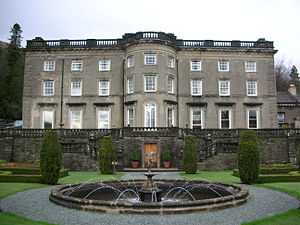Rydal Hall

Rydal Hall is a Grade II* listed house on the outskirts of the village of Rydal, Cumbria in the Lake District, England.[1] It has an early nineteenth-century front facade, but includes some earlier fabric.
It used to be owned by the Le Fleming family, but now is under the ownership of the Diocese of Carlisle. The house is now used for retreats, conferences, courses and holidays in a beautiful situation near Rydal Water. The house is opposite Rydal Mount, home of the poet William Wordsworth.
Rydal Hall is home to Fullcircle Luxury Lake District Yurts. There is also the Old School Room Tea Shop, located on the "Coffin Route" which leads to Grasmere (Wordsworth's home before he moved to Rydal).[2]
Gardens

The gardens are included in the English Heritage Register of Parks and Gardens of Special Historic Interest.[3] In the mid-17th century, Sir Daniel Fleming (1633–1701) developed the landscape as an early Picturesque garden incorporating Rydal Beck and its natural waterfalls. 'The Grot' (a summerhouse designed for viewing a waterfall) became a major attraction for a succession of visiting artists and writers in the 18th and 19th century.
"The Grot" is also described in Wordsworth’s poem, ‘An Evening Walk’. Towards the end of William Wordsworth’s life his nephew Christopher Wordsworth went with him to "The Grot" at Rydal Falls. The following is a description of their walk together from Rydal Mount.
“He accompanied me to the gate and then said if I had a few minutes longer to spare he would like to show me the waterfall which was close by – the lower fall of Rydal. I gladly assented and he led the way across the grounds of Lady Fleming (Rydal Hall) which were opposite to his own to a small summer-house. The moment we opened the door the waterfall was before us. The summer house being so placed as to occupy the exact spot from which it was to be seen. The rocks and shrubbery around closing it in on every side. The effect was magical. The view from the rustic house, the rocky basin into which the water fell and the deep shade in which the whole was enveloped, made it a lovely scene. Wordsworth seemed to have much pleasure in exhibiting this beautiful retreat."[4]
The formal gardens in front of the house were designed in 1909 by the garden designer and landscape architect Thomas Hayton Mawson (1861–1933).[5] Mawson's terraces, which are in Italian stye, are listed structures.[6] These formal gardens were recently restored by Tom Attwood. A community vegetable garden was created at the same time.[7][8]
See also
References
- ↑ http://www.britishlistedbuildings.co.uk/en-452647-rydal-hall-lakes-cumbria/comments
- ↑
- ↑ http://list.english-heritage.org.uk/resultsingle.aspx?uid=1000671
- ↑ Wordsworth, Christopher 1851 “Memoirs of William Wordsworth, Poet-laureate, D. C. L”, p. 495. Online reference http://books.google.com.au/books?id=-ussAAAAYAAJ&q=fleming#v=snippet&q=fleming&f=false
- ↑ Rydal Hall Gardens
- ↑ "Terraces to the South of Rydal Hall". Retrieved 2 January 2014.
- ↑ "Recreating Mawson’s historic Rydal Hall garden". Cumberland and Westmorland Herald. Retrieved 29 November 2013.
- ↑ Mawson Gardens Rydal Hall, Heritage and History.
External links
Coordinates: 54°26′55″N 2°58′48″W / 54.4486°N 2.9801°W